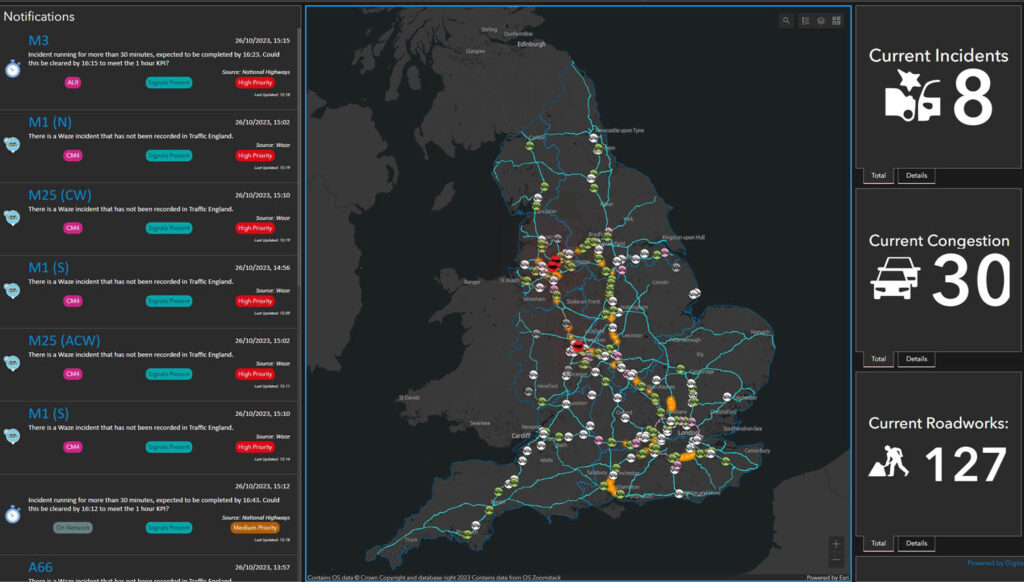Real-time view of England’s motorways and A roads
National Highways and Esri geographic information systems (GIS) software provides staff with single digital model of the strategic road network.
Some 4,500 miles (7,240 km) of motorways and major A roads comprise the core of the transport system in England. It’s critical piece of national infrastructure, connecting major towns and cities and carrying one-third of all traffic and two-thirds of all freight. National Highways is the government organisation responsible for the operation, maintenance and improvement of this strategic road network (SRN).

Image courtesy National Highways / Esri
In 2021, National Highways shared its ambitious Digital Roads strategy for 2025, which included plans to create a ‘digital twin’ of the SRN, developed with funds from the £8.6m EPSRC Digital Roads Prosperity Partnership grant and the £6m EU MSCA COFUND Future Roads Fellowships programme. That has now been accomplished, using Esri GIS to consolidate all geospatial data and applications into one portal, while adding new capabilities and making GIS more accessible at lower cost.
By no longer having to maintain multiple road models (and through other efficiencies), National Highways has reduced its total cost of GIS ownership by more than 10% in the past two years.
As well as producing a single digital model of the SRN, a dashboard provides a real-time ‘Single View of the Network (SVN), an interactive map with incident alerts, weather updates, the locations of available traffic officers and even details of roadworks. This SVN dashboard is not being used in control rooms across the country.
The spatial data being used includes information on the roads themselves but also bridges and tunnels and assets such as road signs and cameras. Together, this data helps to predict problems on the road networks, better coordination to reduce disruption and optimise traffic flow – which in turn reduces both congestion and emissions. Traffic officers can also be deployed more quickly and efficiently.
The impact of this has been recognised across the industry. At Esri’s annual user conference held in California, National Highways received the award for Special Achievement in GIS. It was the only UK winner – which is all the more remarkable given that more than 100,000 entries were submitted worldwide.
Davin Crowley-Sweet, Chief Data Officer at National Highways, says: ‘This award is a significant achievement for our team. Our spatial data is the “crown jewels” of our data landscape – the primary key of primary keys. Having a single view of it to support the whole organisation helps foster a data-driven culture, increasing business benefits and critical for delivering our Digital Roads vision and beyond.
‘We are always looking for new ways to make people’s journeys smoother and safer on our roads and we are now able to react more swiftly to incidents to get traffic moving again as quickly as possible.
‘Meanwhile, our vision for the digital roads of the future will incorporate new capabilities, such as digital twins, predictive planning, single view of assets, and connected autonomous vehicles. Each of these initiatives will require a common, trusted representation of the network to be successful.’
National Highways made the move to an Esri enterprise GIS over a year ago, following recognition that geospatial data was its most critical type of data – the result of an in-depth asset evaluation which valued its data overall at £60bn. Delivered via Esri UK’s Managed Cloud Service, the GIS consolidates all location data into one central system and provides a wide range of applications, data models and other GIS services, enabling 5,660 staff to make better use of spatial data.
Chris Barber, Head of Transport at Esri UK, adds: ‘National Highways is at the forefront of demonstrating what a true enterprise GIS can achieve. Esri technology is helping to maximise the value gained from geospatial data which is now used more extensively across the organisation. Taking an enterprise approach gives National Highways a solid, scalable foundation to help meet its Digital Roads objectives and tackle some of the most pressing challenges facing our roads today and in years to come.’
In related news:
Opinion: A CEO’s conundrum – technology positioning for the bright new world
Call for tech specialists to help solve 8am rush for GP appointments













Leave a Reply